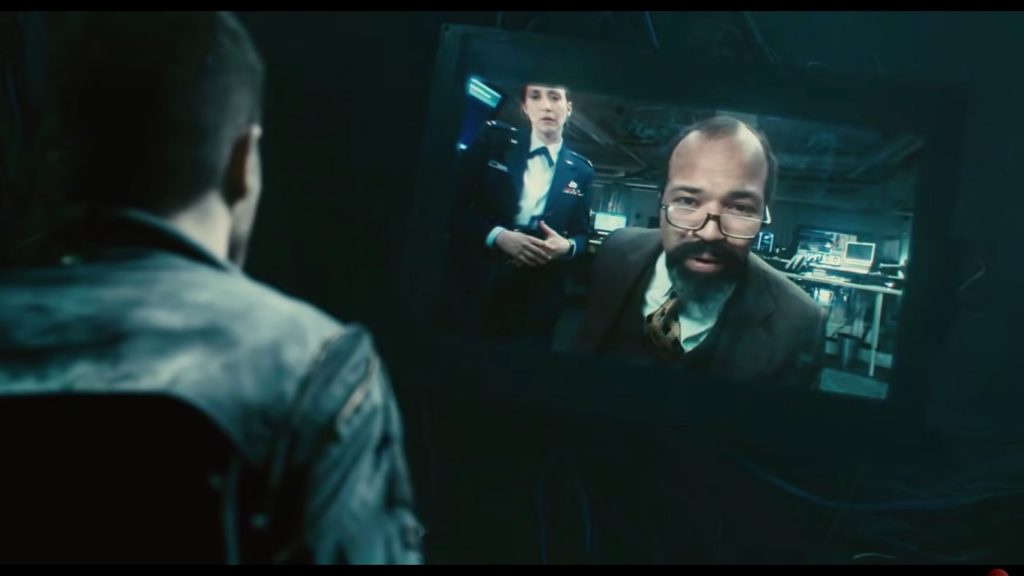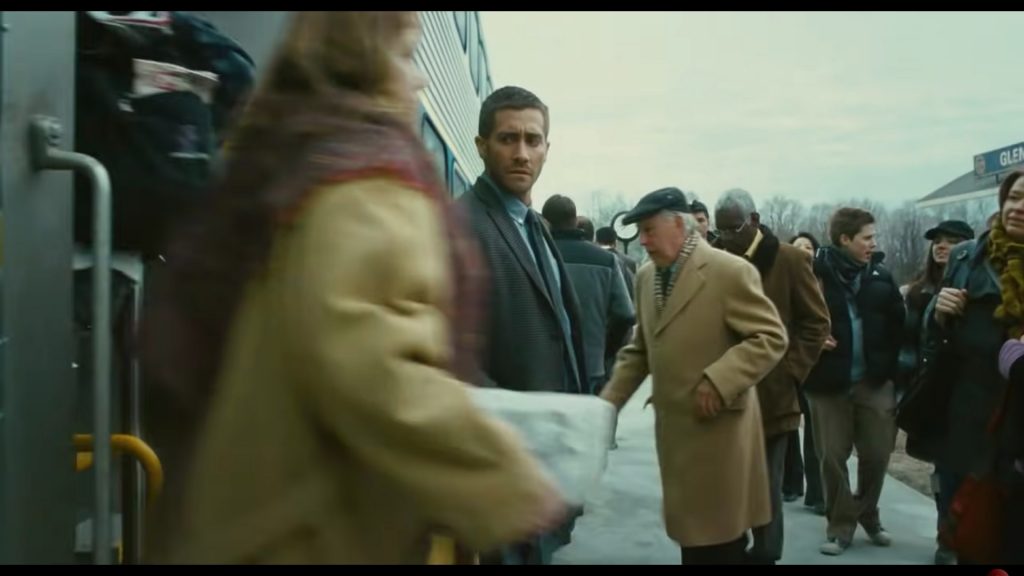Core Data:
- Vision: Crime scene recreations based on memories recovered from the deceased
- Type: Popular culture – film
- As Seen In: Source Code
- Envisioned: 2011
- Visionaries: Duncan Jones (director), Ben Ripley (screenwriter)
- Target Date: Present day
Overview
Oh boy… There’s strong echoes of ’90s sci-fi TV show Quantum Leap in the plot of Source Code, as US Army pilot Captain Colter Stevens (Jake Gyllenhaal) finds himself going back in time, and occupying the body of another human being.
From there the stories diverge, however, as Stevens finds himself in the Groundhog Day-esque scenario of reliving the same eight minutes again and again. His mission? To find the bomb and bomber who destroyed a train in Chicago earlier that day, and prevent any further attacks from taking place.
Over the course of a twisty, turny, timey-wimey hour-and-a-half, Source Code wheels out numerous big sci-fi ideas, including posthumous memories, brain/computer interfaces, and parallel universes. “It’s quantum mechanics, parabolic calculus… very complicated,” says scientist Dr Rutledge (Jeffrey Wright) in the understatement of the century. But just how plausible are the science and technology of Source Code? We dive inside the mainframe to find out – and be warned, there are plenty of spoilers ahead.

Key Tenets
- Hardware: The prototype Source Code technology is based around sophisticated computers that can generate detailed reconstructions of past events.
- These forensic reconstructions are built by pulling together multiple memories harvested from the deceased. Their various perspectives give an over-arching view of what happened during the last moments of their lives – in this case, the minutes leading up to the bomb blast that killed them and the other passengers on the train.
- As well as the aforementioned quantum mechanics and parabolic calculus, the system relies on the idea that the brain retains an electromagnetic “afterglow” for a few minutes after death – much like the brief residual glow of a lightbulb after it’s been turned off.
- Source Code also takes advantage of a (fictional) phenomenon in which the brain keeps a detailed record of the last eight minutes. In the movie, this is compared to a convenience store security camera storing the most recent events before they’re deleted to preserve space on the hard drive.
- The past is recreated by combining these two properties of the human brain – along with a generous dose of outlandish science.
- There’s an essential biological component to the Source Code tech. In order to access the data, a human brain must be plugged directly into the system. This human test subject plays the role of one of the deceased in the reconstruction, and is able to interact with the other victims.
- Not every potential test subject is compatible with the system. In the film, Captain Colter Stevens – aka Subject SC1 – is chosen for the mission because his gender, body size and synaptic maps are a good match for Sean Fentress, whose body he occupies in the Source Code.
- Although the investigator is reliving events in the past, they are not experiencing time travel – instead the process is described as “time reassignment”.
- The subject can have two-way conversations with an operator in the outside world, receiving instructions while passing on key evidence they’ve gathered in the simulation.

- Experience: From the perspective of the investigator, the Source Code simulation feels entirely real. They can see, hear, touch, taste and smell as if they were actually there.
- They take on the appearance of the body they’re ‘possessing’. Like Dr Sam Beckett in Quantum Leap, they find themselves facing mirror images that are not their own.
- The investigator can alter the course of events within the simulation, but is unable to influence events in the real world.
- In between the eight-minute replays, the investigator is held in a waiting room. For Captain Stevens, this resembles a helicopter cockpit.
- In this waiting room, Stevens is able to communicate with an operator in the outside world. They appear via a video screen to him, while his responses are translated into text for the operator.
- Over the course of the movie, it’s gradually revealed that Captain Stevens was declared dead two months earlier, after injuries he sustained in a firefight in Kandahar, Afghanistan. What remains of his body is being kept alive by artificial means at the Source Code facility, his brain wired up to the system.
- Although there’s nothing left of Stevens below the thorax, he sees a ‘complete’ version of himself based on residual memories.
- Stevens and the other residents of the reconstruction are not actually trapped within the original eight-minute time loop as is initially believed. While the start point is fixed, it later turns out that the simulation can continue beyond the original program, unfolding into a brand-new parallel timeline where the future is not set.
- Company: The prototype Source Code technology is invented and developed by Dr Rutledge.
- The research is bankrolled by the US military.
- The project is codenamed Beleaguered Castle. It takes its name from a version of patience/solitaire.
- Economics: After the success of Captain Stevens’ mission, Dr Rutledge moves to gain extra funding from the US Department of Defense.
- There is, however, a flaw with his plan – no candidate other than Stevens has so far been compatible with the system. When Captain Coleen Goodwin agrees to Stevens’ request to let him die, Source Code is suddenly left without a viable operating system.
- IP: The contents of the human mind are the only IP the system needs.

State of Play (July 2022)
- Hardware: Forensic scientists piece together data from multiple sources to recreate a crime scene. Meanwhile, recording images from multiple angles provides you with the data you need to create a 3D simulation of a scene. The fundamental logic at the heart of Source Code is therefore sound.
- The problem is more that it’s based on technology that doesn’t yet exist, and may never be feasible.
- Direct interfaces between the brain and a computer are currently nowhere near the sophistication of the system that connects Captain Colter to Source Code. While it’s possible to pass simple commands from a human nervous system to a machine, sending or receiving images, sounds and memories is pure sci-fi. As it stands, the brain is incompatible with both Windows and MacOS.
- While Captain Stevens has lost most of his body, this Q&A from BBC Science Focus suggests it would be theoretically possible for the Beleaguered Castle scientists to prolong his life. With medical assistance, a human can survive without limbs, various internal organs and sections of the intestines. However, the scale of the trauma Stevens suffered in Afghanistan could have proved fatal due to shock and/or blood loss. His quality of life would also be severely impaired.
- Experience: On a practical level, little of Source Code is plausible. For example, would evidence gathered by a lone operator who’s been declared legally dead – with no living witnesses to verify the information he’s collected – be admissible in court?
- And how reliable would that evidence be? The human mind is far from photographic, and every viewer would undoubtedly apply their own biases to their interpretation of events, whether alive or dead. The chances of data from dozens of disparate witnesses being consistent enough to accurately document events seem slim.
- Enrolling someone for a project like Source Code without their consent is morally dubious to say the least. Can work carried out after death be considered “in the line of duty”?
- As for memories surviving posthumously… “It’s inconceivable that you could trace brain activity back eight minutes after death,” said neuroscientist Professor Irving Biederman in an interview with Wired about the science of Source Code. “The premise is highly implausible, and that’s an understatement. The notion that we could recover [activity generated by] those billions of neurons after a person has died is inconceivable. We can’t even do that in a monkey or rat that’s alive.”
- That said, it might one day be possible to identify a suspect from the last thing a murder victim saw. In a study by researchers Russell and Karen De Valois, a monkey was injected with radioactive tracers and shown a grid pattern just before they die – the scientists subsequently managed to detect a representation of the grid in the late simian’s brain tissue.
- Even if the eight-minute memory theory did hold water, recovering that data from human brains in the aftermath of a major accident like the bombing in Source Code would be extremely challenging. Not only would getting past the debris to find the bodies be problematic, there’s a good chance that the explosion would have severely damaged the brains of the victims. The fact that this information has seemingly been recovered within hours – it’s constantly reiterated that time is of the essence in the race to prevent another bombing – makes Source Code’s grip on reality even more tenuous.
- Dr Rutledge briefly talks about wiping Stevens’ memory so he can be dispatched on another mission – a process that may have already taken place when the movie begins, judging by the captain’s disorientation and amnesia when he first takes a ride on the ill-fated train. The erasure process is not described in the film, though various techniques have been explored in real life – whether via drugs, disrupting/destroying key neurons, or by encouraging subjects to suppress memories. These methods are currently too crude, however, to target specific memories. Besides, there would be major moral questions about surgically removing a specific memory: if you targeted a particular recollection, would you be removing something that helped define someone’s personality? And who would have the right to decide which memories should be removed?
- The Source Code simulation “knows” things it couldn’t possibly know. For example, Stevens accosts the terrorist and finds the dirty bomb he’s about to detonate, even though no one who died on the train would have any way of knowing they existed. Based on data collected from the brains of a few hundred people, the computer seems to have constructed a flawless recreation of a whole parallel world – and, who knows, perhaps an entire universe.
- Bizarrely, the weirdest concept in Source Code may just be the most believable. The “many-worlds interpretation” of quantum mechanics is a credible theory in physics, that effectively states that all possible events will occur in some universe somewhere. Unfortunately, there’s no scientifically feasible way of moving between the universes. The theory also struggles to explain how one of these worlds could exist inside a computer…

- Economics: If the Source Code technology did exist, its potential applications would be limitless – though it’s unlikely its creators’ first port of call would be anything as altruistic as law enforcement. In effect, a simulation this sophisticated has the ability to predict the future, making it invaluable for financial markets, governments and the military – anyone in possession of similar tech would have an unprecedented competitive advantage. The creators could also make billions from exploiting the bereaved, giving them an opportunity to communicate with simulations of loved ones who’ve passed away.
Reality check: great ideas, shame about the science
There’s no shortage of ingenious ideas in Source Code, but when you drill down into the science it doesn’t make a whole lot of sense. Not that it really matters: as screenwriter Ben Ripley put it, “Source Code is a character mystery and the thriller plot is simply the engine.”
Further reference:
A self-confessed full-time geek, freelance journalist Richard has spent most of his career writing about sci-fi and fantasy – including more than a decade on staff for SFX magazine. He's particularly keen on franchises with "Star" in the title.






































